I am particularly interested in visiting regional museums, places that are less likely to see a large influx of visitors, or to receive as much governmental funding. I am interested in seeing the impact this has on the museum itself - in terms of displays, the didactics (text panels & labelling), the information available to visitors, its perceived audience and its online presence (which is the beating heart of all the major cultural institutions we know).
A few weeks ago, a weekend visit from a dear friend prompted a visit to the village of Bellanaleck on the outskirts of Enniskillen, just under an hour away by car from Sligo.
The Sheelin Antique Irish Lace Museum and Shop is housed cosily within a beautiful thatched cottage, with tearooms adjacent, owned by the same family.
You gain entry to the museum through the shop, which itself sells a range of beautiful antique Irish and European lace, as well as vintage wedding gowns and accessories. My only purchase was a 50p postcard! It really is a charming entrance, and heightens the anticipation as you enter further inside, to find the museum at the rear of the shop.
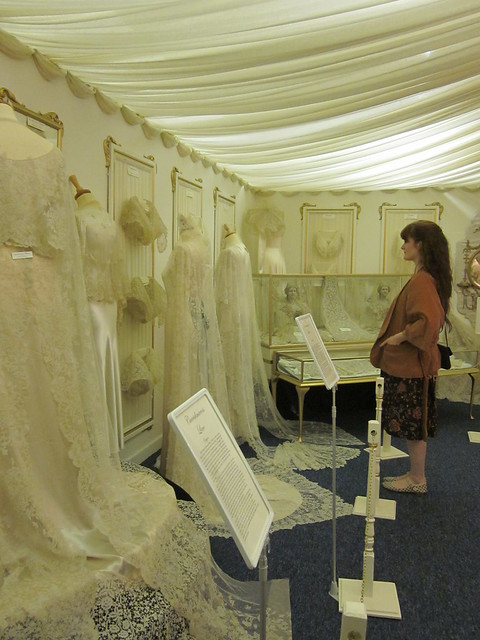
View of museum displays (with a cameo by yours truly!)

Irish crochet jacket, lace jacket - the displays were a mix of hand worked lace and machine lace - but the information panels didn't specify the differences, which we would have liked to have known, so we made some amateur guesses ourselves.*
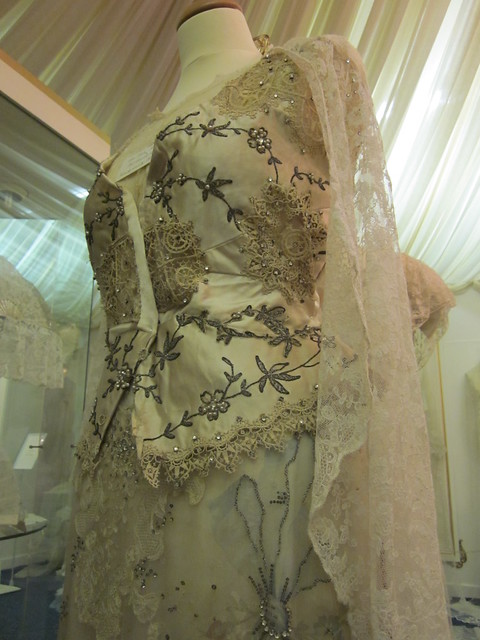

This dress was donated by a member of the McGuinness family (the name escapes me now), with hand-painted floral detail and possibly swarovski crystals adorning the skirt. Some of the detail looks to have been added by hand but I can't be sure.
The detail adorns every element of the dresses on display. Imagine the effect once of these gowns trailing across the floor at a grand ball would have made. It really is beautifully laid out, it gives the visitor a sense of intimacy as opposed to the sterile atmosphere typically found in museums. Being a regional museum, with a smaller audience, and an adjoining shop selling antique lace, they have an advantage over larger museums whom would have a larger volume of people and therefore would need to be more protective of their fragile and valuable exhibits. I felt quite privileged as I walked around, almost as if I was a trusted confidante walking around the substantial wardrobe of a nineteenth-century socialite.
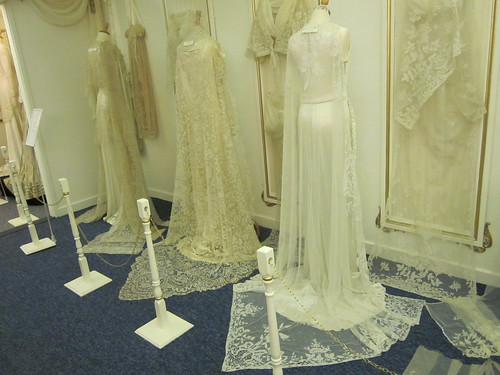
I loved how the dresses were presented on these mannequins, displaying them to their full effect. I however, would have liked to have known the provenance of these dresses. The only information given was on a number of discrete text panels, which explained the different types of Irish lace (Carrickmacross lace, Limerick lace, Irish crochet, Youghal lace, etc).

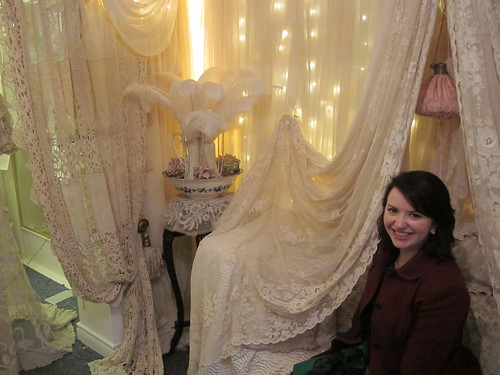
The sight of so many dresses, flounces and fans set us into a state of girly excitement, so we took some pictures to give an impression of the romantic aesthetic effect of the museum and shop.
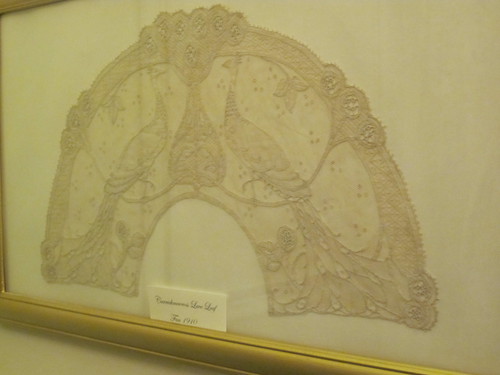
Carrickmacross lace piece, with peacock detail. Dated 1910. The majority of the pieces in the museum date from the 1890s - 1910s, a highly productive period in Irish lacemaking.
I only wish that I had taken a notebook with me to note the different styles of my favourite dresses on display and I could have been more specific in this post, but if you're in this part of the world you may be tempted to come!
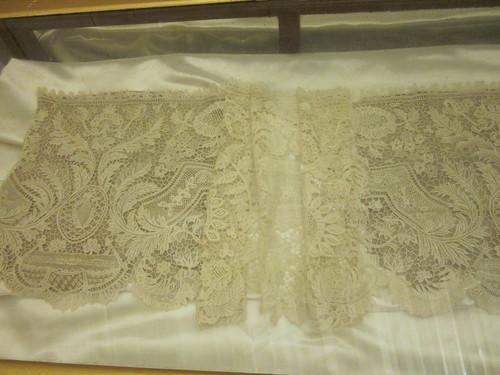
Also on display is a beautiful Youghal needlelace flounce, with harps and music note detailing, formally owned by the family of the late princess, Lady Diana Spencer. This type of "Irishy" design was very common for the period, usually commissioned by rich Ladies as a tangible display of their philanthropic interests (such as the Irish cause/helping the Irish poor).
The shop is a literal boudoir, a bride-to-be's dream, and more.

Ornate hankerchiefs of Limerick and Carrickmacross lace.
After feasting our eyes on the aesthetic delights that the small museum and shop offered, we decided to treat ourselves to some afternoon tea in the Sheelin Tea Rooms next door. I'm sure the convenience offered by the benefits both the shop and the museum. I enjoyed a victoria sponge, whilst my friend and father had the apple tart. The staffed seemed rushed off their feet, the small tea room was about two thirds full on this Saturday afternoon.
Entry to the museum is £2.50 per person, which in my eyes is perfectly reasonable, considering you are making a small contribution to the continuation of this wonderful gem in the Fermanagh countryside. The museum opens from April through to October. I was pleasantly surprised that the guestbook had signatures from all over the world.
POSTSCRIPT
Some background history...
The revival of Irish lace and the cottage industries
The cottage industries in Ireland were the projects of philanthropists. Their aim was to provide “relief work” for the rural peasantry, supplying workers with a regular income for their family, and an occupation. For these lady philanthropists the notion of revitalising the countryside held a more personal motivation, it carried a powerful humanitarian and patriotic appeal. In these areas the basic production standards were in place for the creation of textiles but they were in need of updating in terms of style and quality, in order to market them to the fashion conscious urban consumer. Designs for lace
Queen Victoria was a fervent patron of Irish lace, and encouraged the ladies within her court to purchase and wear Irish lace. The purchase of national products had become a fashionable cause during the latter part of the century. The drive to buy British was a large boost to the regeneration of cottage industries. A significant part of the attraction included the revival of what was perceived as “national patterns” (harps, shamrocks, etc).
*I have since been in touch with Rosemary Cathcart who informs me that all the antique lace in the museum is hand worked and there is no machine made lace amongst the collection. (8/6/2012)
Read more:
Cottage Industries: Arts and Crafts in Donegal, 1880-1920
Cottage Industries In Scotland And Ireland
Art and the National Dream: Search for Vernacular Expression in Turn-of-the-century Design
British and Irish Home Arts and Industries 1880-1914: Marketing Craft, Making Fashion


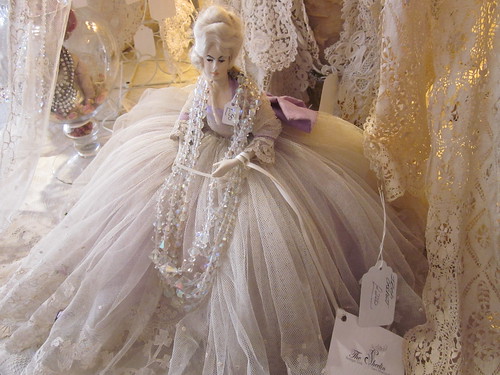
This is positively dreamy.
ReplyDeleteThis was such an interesting blog post, Zoe! I did not know that cottage industries were seen as "relief work" for the peasantry. This is very different from the linen mills (I'm slightly more familiar with their history). Do you have any information on weavers? Were they more "workers" or beneficiaries of philanthropy?
ReplyDeleteBeautiful photos as well, absolutely lovely. Nice to see Queen V is not the only one with a penchant for Irish linen: wasn't Kate Middleton's wedding dress Irish lace too?
I may do a follow up post Maeve, because Kate Middleton's gown was indeed! Carrickmacross lace.
DeleteI'm not too familiar with the story of Irish linen, need to get reading more i think! Its a complicated history, it was a mixture of both. The designs for lace were often drawn up by English or English educated designers, and passed down to the workers so they would work in the fashion of the time - keep with the trends as it were. As we know, in fashion history certainly, the body was politic - wealthy women who purchased this lace were keen to promote their philanthropic activities - a lot of lace designs contained typical "Irishy" imagery - harps, shamrocks, etc.
Appreciation for the captivating post, people! 🙌 If you really love Lionel Messi and Argentina, you can't miss the Australia Soccer Jersey! 🇦🇷✨ Get yours today at soccerjerseyforsale.com and take part in a crucial 40% off! ⚽️ Don't stop, this prohibitive course of action won't continue to go long!
ReplyDelete